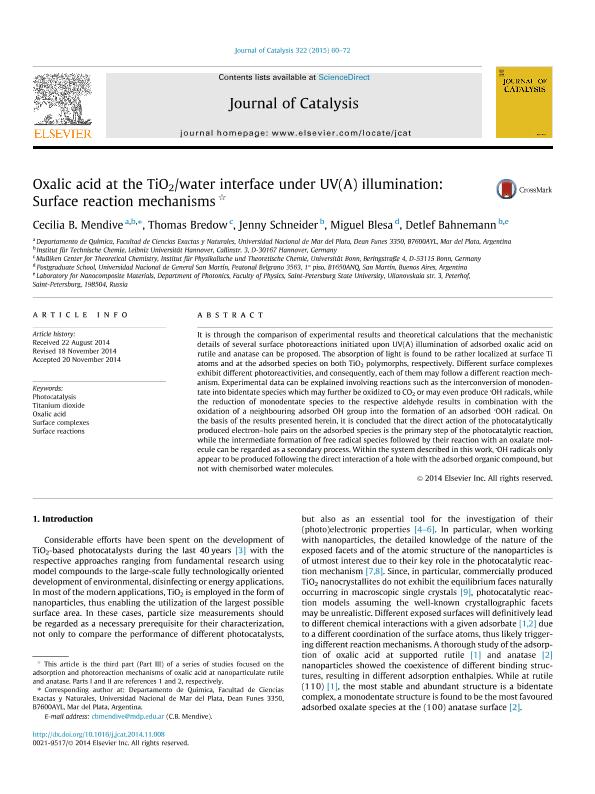Artículo
Oxalic acid at the TiO2/water interface under UV(A) illumination: Surface reaction mechanisms
Mendive, Cecilia Beatriz ; Bredow, Thomas; Schneider, Jenny; Blesa, Miguel Angel
; Bredow, Thomas; Schneider, Jenny; Blesa, Miguel Angel ; Bahnemann, Detlef
; Bahnemann, Detlef
 ; Bredow, Thomas; Schneider, Jenny; Blesa, Miguel Angel
; Bredow, Thomas; Schneider, Jenny; Blesa, Miguel Angel ; Bahnemann, Detlef
; Bahnemann, Detlef
Fecha de publicación:
02/2015
Editorial:
Academic Press Inc Elsevier Science
Revista:
Journal of Catalysis
ISSN:
0021-9517
Idioma:
Inglés
Tipo de recurso:
Artículo publicado
Clasificación temática:
Resumen
It is through the comparison of experimental results and theoretical calculations that the mechanistic details of several surface photoreactions initiated upon UV(A) illumination of adsorbed oxalic acid on rutile and anatase can be proposed. The absorption of light is found to be rather localized at surface Ti atoms and at the adsorbed species on both TiO2 polymorphs, respectively. Different surface complexes exhibit different photoreactivities, and consequently, each of them may follow a different reaction mechanism. Experimental data can be explained involving reactions such as the interconversion of monodentate into bidentate species which may further be oxidized to CO2 or may even produce OH radicals, while the reduction of monodentate species to the respective aldehyde results in combination with the oxidation of a neighbouring adsorbed OH group into the formation of an adsorbed OOH radical. On the basis of the results presented herein, it is concluded that the direct action of the photocatalytically produced electron-hole pairs on the adsorbed species is the primary step of the photocatalytic reaction, while the intermediate formation of free radical species followed by their reaction with an oxalate molecule can be regarded as a secondary process. Within the system described in this work, OH radicals only appear to be produced following the direct interaction of a hole with the adsorbed organic compound, but not with chemisorbed water molecules.
Archivos asociados
Licencia
Identificadores
Colecciones
Articulos(CCT - MAR DEL PLATA)
Articulos de CTRO.CIENTIFICO TECNOL.CONICET - MAR DEL PLATA
Articulos de CTRO.CIENTIFICO TECNOL.CONICET - MAR DEL PLATA
Citación
Mendive, Cecilia Beatriz; Bredow, Thomas; Schneider, Jenny; Blesa, Miguel Angel; Bahnemann, Detlef; Oxalic acid at the TiO2/water interface under UV(A) illumination: Surface reaction mechanisms; Academic Press Inc Elsevier Science; Journal of Catalysis; 322; 2-2015; 60-72
Compartir
Altmétricas



